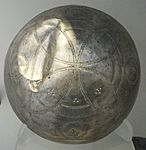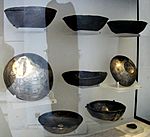St Ninian's Isle Treasure facts for kids
Quick facts for kids St Ninian's Isle Treasure |
|
|---|---|
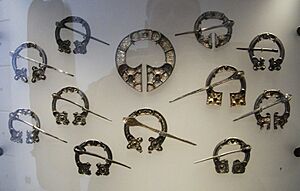
Pennanular brooches
|
|
| Material | Silver, Silver-gilt |
| Period/culture | c.750–825 AD |
| Discovered | 4 July 1958 |
| Place | St Ninian's Isle, Scotland |
| Present location | National Museum of Scotland |
The St Ninian's Isle Treasure is a famous collection of silver objects found on St Ninian's Isle in Scotland in 1958. It's one of the best examples of silver metalwork from the Early Medieval period in Scotland.
This amazing treasure has 28 pieces, mostly made of silver. It includes twelve pennanular brooches, which are a type of pin used to fasten clothes. Today, you can see the treasure at the National Museum of Scotland in Edinburgh.
What's in the Treasure?
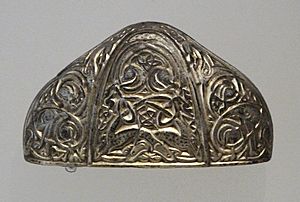
The St Ninian's Isle Treasure has 28 items made of silver or silver-gilt (silver with a thin layer of gold). These objects were made around the late 700s AD. They can be grouped into things used for eating, jewelry, and weapons.
The treasure includes:
- Twelve silver penannular brooches. These are round or oval pins with a gap, used to hold cloaks or clothing.
- Eight silver bowls.
- One silver spoon, possibly used in church services.
- One silver knife.
- Two silver chapes (metal fittings from the end of sword scabbards, which are sword cases).
- One silver pommel (the end part of a sword handle).
- Three silver cones.
There's also one small piece of a porpoise jawbone, which is the only item not made of metal.
Some items, like the brooches and sword parts, were likely used in everyday life or by important people. Other pieces, such as the bowls, spoon, and cones, might have been used in religious ceremonies or community events.
The brooches show different styles of Pictish art. The Picts were an ancient people who lived in Scotland. Some of the sword parts look like they were made by the Anglo-Saxons in England. This shows that rulers from different areas often exchanged gifts, especially weapons.
How the Treasure Was Found
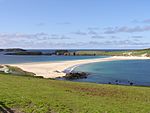
The treasure was found on July 4, 1958. A schoolboy named Douglas Coutts made the discovery. He was helping archaeologists dig at an old medieval chapel on St Ninian's Isle.
Douglas found the treasure hidden in a wooden box. The box was buried under a stone slab that had a cross carved on it. It's thought that the treasure was hidden under the floor of an even older church building.
Professor Andrew Charles O'Dell from Aberdeen University was leading the archaeology team. He later wrote about the discovery. He explained that the old church had been forgotten over time. Sand had covered its remains, and people no longer knew exactly where it was.
Archaeologists started looking for the church in 1955. Their hard work paid off when Douglas Coutts found the treasure in 1958. The silver bowls were found upside down, and the other items were tangled together. This suggests the treasure was quickly buried, perhaps to keep it safe. The porpoise jawbone found with the treasure might mean it had a connection to the church.
The St Ninian's Isle Treasure was given to the National Museum of Antiquities of Scotland in 1965-66. This museum is now part of the National Museum of Scotland in Edinburgh. You can see copies of the treasure at the Shetland Museum.
Gallery


